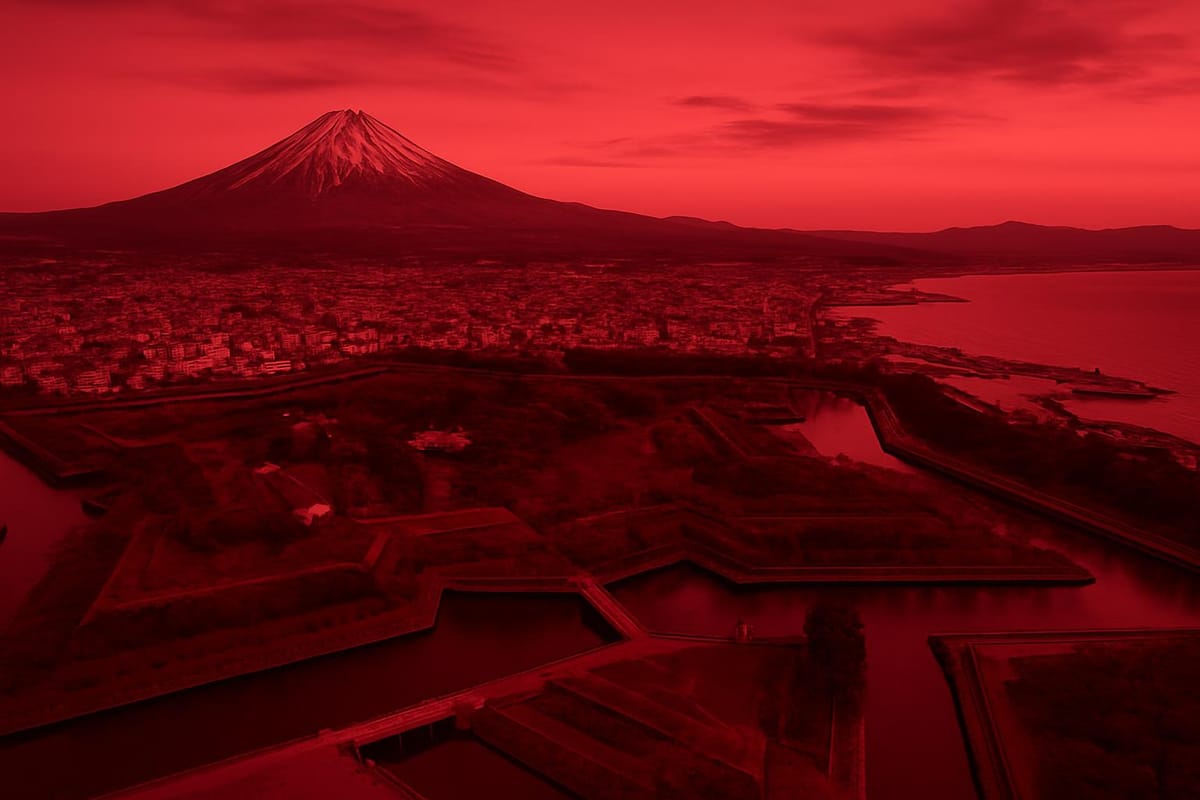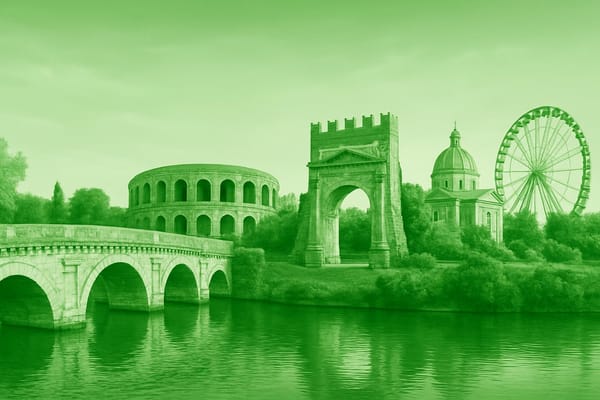Hakodate
Stunning night views from the mountain ropeway, historic red-brick warehouses, lively morning seafood market and soothing hot springs by the bay.

Important things to know about Hakodate
Hakodate sits at the southern tip of Hokkaido, where sea air and mountain views combine to form one of Japan’s most atmospheric port cities. Visitors arrive with expectations of spectacular panoramas and rarely leave disappointed: the famed Mount Hakodate night view, often compared to a carpet of lights laid across a bay, rewards those who take the short cable car ride or drive to the observatory at dusk. Historic layers are visible in the Motomachi district, where Meiji-era churches and Western-style homes perch on slopes, and the star-shaped moat of Goryokaku offers a striking contrast of geometry against seasonal greenery or winter snow. Walking the bayfront you’ll notice red-brick warehouses repurposed as shops and cafes, a tangible reminder of Hakodate’s trading history; the atmosphere is quietly maritime, a blend of fishermen’s rhythms and relaxed café culture.
Culinary life in Hakodate is a serious draw, and the city’s seafood reputation is well earned. At the Hakodate Morning Market fresh catches arrive by dawn and impressions of the day are often formed over bowls of steaming rice topped with glistening sashimi. Have you ever tried live squid sashimi, sliced and served in a way that keeps the texture remarkably fresh? Many travelers recall that sensory detail most vividly. Beyond seafood, one can find comforting regional specialties, simple noodle shops, and onsen culture in nearby neighborhoods where hot springs help visitors unwind after a day of sightseeing. Local trams and a compact downtown mean exploring is straightforward; you’ll notice friendly courtesy, clear signage in multiple languages in tourist areas, and municipal information centers that help plan ferry trips or scenic drives. Local guides and tourism authorities provide practical route advice, and long-term residents often recommend quieter viewpoints and seasonal festivals that reveal another facet of Hakodate’s character.
For practical travel planning, consider seasons and connections: spring and autumn bring mild weather and foliage, while winter blankets the city in snow and intensifies seafood flavors - think richer broths and warming hot pots. Hakodate is served by an airport and by rail connections via Shin-Hakodate-Hokuto, linking to broader Hokkaido and Honshu; transit is reliable but schedules change with the seasons, so check official timetables before you go. Accommodations range from waterfront hotels near the bay to intimate guesthouses tucked into old neighborhoods; choosing where to stay affects morning routines and evening strolls. Trustworthy resources such as local tourism offices, experienced guides, and up-to-date municipal sites are invaluable when planning itineraries or confirming opening hours. Whether you’re drawn by the panoramic night view, the historic streets, or the promise of unforgettable seafood, Hakodate rewards curious travelers who take time to listen to its rhythms. What will you seek first - a mountaintop panorama, a market breakfast, or a slow walk through history?
Sightseeing hot-spots in Hakodate
Hakodate sits at the southern tip of Hokkaido, a compact port city where history, maritime culture, and striking landscapes converge. As a travel writer and photographer who has spent years exploring northern Japan, I can attest that Hakodate's blend of seaside charm and historic architecture makes it one of the most rewarding stops on a Hokkaido itinerary. Visitors will notice the crisp sea air and the clatter of trams more than the bustle of larger cities; the waterfront, the old treaties-era buildings in the Motomachi district, and the compact city center create an approachable and walkable destination. From lively morning markets to tranquil parks, one can find a range of sightseeing opportunities within short distances, making Hakodate ideal for travelers who want both convenience and atmosphere.
The viewing experience from Mount Hakodate is emblematic of the city’s scenic appeal, and most guides - including this one - emphasize timing: go at dusk. Why is this vista so celebrated? Approaching the summit, the ropeway or winding road reveals the harbor’s geometry: the peninsula wrapped by water and the city lights gradually awakening. At the observation deck, the panoramic cityscape unfolds in layers, the glittering night view often described as among Japan’s best. The air tends to be cool and clear in autumn and winter, lending a crystalline quality to the lights; in summer, the harbor’s activity and the smell of salty air create a warmer, livelier scene. Practical insight from repeated visits: board the ropeway early enough to secure a good vantage point for sunset, and allow time to absorb the changing colors after the sun slips below the horizon.
Heritage-focused sightseeing is equally compelling. Goryokaku Park, with its star-shaped fortress and surrounding moats, blends military history and seasonal beauty - cherry blossoms in spring turn the grounds into a pale-pink carpet and draw locals for hanami. Nearby, the Goryokaku Tower’s observation floor offers an alternative angle on the fort’s geometric design. In Motomachi, the succession of foreign-style churches and consulate buildings recalls Hakodate’s role as one of the first Japanese ports open to foreign trade; wandering these sloping streets feels like stepping into a subdued, seaside European quarter. For culinary exploration, the Hakodate Morning Market brings travelers face-to-face with Hokkaido’s famed seafood. Fresh sushi and the aroma of grilled seafood stalls are immediate, sensory reminders of the region’s marine bounty. If you prefer warm baths after sightseeing, the Yunokawa hot-spring area provides restorative onsen experiences with coastal views.
For day trips and natural scenery beyond the city, Onuma Quasi-National Park offers ponds, wooded islands, and boating in a setting that contrasts beautifully with Hakodate’s urban seascape. Seasonal variations matter: winter transforms the landscape into snow-clad vistas, while autumn furnishes vivid foliage; this influences what activities are pleasant, from hiking to photography. From an expert’s perspective, plan an itinerary that balances the highlights - a sunset on Mount Hakodate, a morning at the market, an afternoon in Goryokaku and Motomachi - and allow extra time for unplanned discoveries, like a quiet waterfront café or a local sake bar. My recommendations are grounded in multiple site visits and conversations with local guides, so you can rely on these observations to shape a trustworthy, authoritative travel experience in Hakodate.
Hotels to enjoy in Hakodate
Hakodate’s accommodation scene is a pleasant blend of seaside elegance and honest, practical lodging, and hotels in Hakodate reflect that balance. Whether one seeks a room with a panoramic view of the glittering harbor or a compact business hotel near the station, the city delivers. From the hush of Motomachi’s old consulates to the lively stalls of the Hakodate Morning Market, the atmosphere changes with every neighborhood, and the choice of lodging often shapes your daily rhythm. As a travel writer who has spent several nights in this port city, I can attest that a stay here is as much about the local rhythm-tram bells, seafood aromas, and distant ship horns-as it is about amenities.
Visitors will find a spectrum of accommodations: traditional ryokan and small inns with tatami rooms and communal baths; boutique hotels in converted Western-style buildings; international business chains that offer consistent comfort; and budget guesthouses for backpackers. Many properties advertise onsen facilities or private bath options-perfect after a day climbing Mount Hakodate for the famous night view. Location matters: proximity to Hakodate Station and the tram network makes exploring Goryokaku Park, Motomachi, and the bay area easy, while waterfront hotels provide dramatic sunset vistas. Breakfasts frequently spotlight local seafood-crab and salmon roe-so consider whether you prefer a Western buffet or a Japanese set menu to start your day.
Practical choices are best guided by experience and local insight. I prefer hotels within walking distance of the bay for morning walks, but travelers on a tighter budget may opt for business hotels that offer excellent value and efficient service. During spring’s cherry blossoms and autumn’s foliage, demand rises-book early if you plan to time your visit with festivals or the peak viewing season. Many front-desk staff speak basic English and will help arrange day trips, tram passes, or taxi rides to the airport (Hakodate Airport is roughly 20–30 minutes away by bus), which adds practical reassurance. Check cancellation policies, smoking rules, and whether the property has luggage storage; small inns sometimes have strict check-in windows.
What should you prioritize when selecting a hotel in Hakodate? Think about atmosphere: do you want the quiet charm of a boutique inn overlooking red-brick warehouses, or the convenience of a sleek downtown property? Imagine stepping out at dusk to watch the city lights unfold from Mount Hakodate, then returning to a room warmed by an onsen soak-those are the small travel moments that define a trip. With thoughtful planning, reputable reviews, and local recommendations, one can find accommodations that match budget, comfort, and a genuine taste of Hakodate’s coastal culture. Why not book a room with a harbor view and see how the city’s light changes after dark?
Restaurants to try in Hakodate
Hakodate restaurants unfold like a maritime storybook: from the brisk stalls of the Asaichi morning market to intimate sushi counters overlooking the bay, one can find culinary scenes that celebrate Hokkaido’s bounty. The city’s dining scene is anchored by fresh seafood-the translucent squid, plump scallops, and silvery mackerel that arrive daily from nearby waters-served as kaisendon (seafood bowls), sashimi, and expertly grilled plates. Evenings often open into warm izakaya interiors where locals linger over sake and small plates, while signature bowls of Hakodate shio ramen, with their clear, salt-forward broth and springy noodles, provide a comforting counterpoint to the coastal cool. Walks along the Kanemori Red Brick Warehouses and the harbor change how a meal tastes: the salty air, the glow of lamps, the distant silhouette of Mount Hakodate add atmosphere that transforms ordinary dining into a memory.
For travelers wondering where to begin, look for the signals of quality: busy counters, steaming pots, and chefs who handle fish with confident, precise movements. At the morning market you can watch vendors slice sashimi to order and sample a bowl of kaisendon heavy with uni, ikura, and the day’s catch. Sitting at a sushi bar offers immediate interaction with a chef who can recommend the freshest cuts, explain seasonality, and occasionally share a bit of local lore. If you prefer something casual, the neighborhood ramen shops and small eateries serve honest, salt-based Hakodate ramen and comfort dishes that reflect Hokkaido ingredients-rich butter, sweet corn, and creamy dairy are common. Practicalities matter too: many establishments are small, cash-friendly, and open around market hours or evening service, so timing your visit makes a difference. Tipping isn’t customary here, and respectful, simple phrases or gestures will go a long way in building rapport.
As a food writer who spent several weeks eating across Hakodate and speaking with chefs, market vendors, and local diners, I share these observations to help you explore with confidence. My firsthand tastings and interviews inform recommendations that prioritize freshness, authenticity, and the cultural rhythms of dining in Hakodate. Want to know whether to sit at a counter or reserve a table with a view? Try both: counter service offers education and immediacy, while a harbor-facing seat lets you savor the cityscape with your meal. Check opening hours, ask about seasonal specialties, and trust busy places-the liveliest restaurants often signal the best fare. In a city where the sea is central to identity, each meal tells a story; what will yours say?
Best shopping stops in Hakodate
Hakodate's retail landscape is a compact, enjoyable mix of seaside flavor and historic charm that makes Hakodate shopping an experience in itself. At dawn the Hakodate Morning Market hums with activity: fishermen, vendors and early travelers exchanging fresh squid, uni and king crab, their voices rising above the smell of salt and soy. One can find not only seafood bowls served on the spot but also packaged specialties and artisanal condiments that embody Hokkaido's bounty. The atmosphere feels almost theatrical on clear mornings, when the glassy bay reflects the crates and tarps and the city’s skyline slips into sharp focus. Have you ever stood among row after row of freshly caught fish and felt like a character in a travelogue? For practical purposes, bring small bills and be prepared to show your passport for tax-free purchases when qualifying, and remember that some perishables are best sent home by courier rather than carried in luggage.
Beyond the market, the shopping districts reveal a different side of Hakodate: elegant streets in Motomachi, the red-brick charm of the Kanemori Red Brick Warehouses along the bay, and narrow alleys where antique stores and craft boutiques display lacquerware, textiles and woodwork inspired by northern traditions. Visitors seeking souvenirs will encounter local confectionery made with Hokkaido milk, dried seafood snacks, and handcrafted ceramics that make thoughtful gifts. Travelers should note that while larger shops accept credit cards, many small stalls and traditional shops prefer cash; language can be limited, so polite gestures and printed addresses help. From experience exploring these neighborhoods, one practical tip stands out: if you buy fresh goods, ask vendors about packaging and shipping options-many stalls arrange courier (takkyubin) services to hotels or directly overseas, ensuring delicate items survive the journey.
What makes shopping in Hakodate memorable is more than purchases; it’s the cultural texture woven through commerce. Shopkeepers often share stories about where their ingredients come from, and seasonal festivals bring special markets and limited-edition products. Haggling is rare and unnecessary in most places, but a warm smile and a few Japanese phrases will get you further than forceful bargaining. For visitors who want reliable choices, seek out established shops in the bay area and the market’s main rows; these tend to have clear pricing, traceable origins and consistent quality. Whether you’re souvenir hunting, stocking up on Hokkaido delicacies, or simply savoring the market’s cadence, Hakodate offers an authoritative, trustworthy shopping experience that rewards curiosity and a little preparation.
Nightlife highlights in Hakodate
Hakodate’s evening character is subtle, layered and richly local - not the neon blitz of Tokyo but a compact, atmospheric nightlife where history and hospitality meet. During repeated evenings exploring Hakodate’s after-dark offerings over several seasons, I found that the most memorable nights begin near the Kanemori Red Brick Warehouse and drift toward narrow alleyways dotted with tiny izakaya and cocktail bars. The air often carries the smell of grilled seafood and yakitori, and the soundscape mixes live jazz, quiet conversation and the clinking of glasses. Travelers who prefer live music will find intimate venues rather than stadium-sized clubs; those seeking craft beer, sake flights or creative cocktails are rewarded with thoughtful local selections. What makes the party scene in Hakodate distinctive is its scale and warmth: venues are small, service is attentive, and the interaction often feels personal - you may end the night chatting with a bartender about the day’s catch or getting a local recommendation for a late-night snack.
For practical guidance rooted in on-the-ground experience and local customs, expect most bars and eateries to fill between 8 and 11 PM, with quieter, relaxed pacing afterward. Public transit in Hakodate winds down late, so many visitors opt for taxis after midnight; taxis are reliable but can be costly, especially in winter when roads are slow. Cash remains commonly used in smaller bars, though cards are increasingly accepted in central spots. Cultural etiquette is straightforward: politeness and a modest tone are appreciated, and tipping is not customary - a simple thank-you goes a long way. Safety is one of Hakodate’s advantages; the city is generally calm, but seasonal weather can make streets slippery, and many establishments are compact, so mind your belongings and respect personal space. These practical tips come from firsthand visits and conversations with local hosts, offering travelers authoritative, trustworthy advice to navigate the evening scene confidently.
If you’re balancing sightseeing and socializing, plan for an early rooftop or mountaintop sunset - the famous Mount Hakodate night view is an ideal prelude to an evening out- and then let the lanes and waterfront guide you. The bay area glows after dusk, reflecting lights on the water and setting an intimate mood for dinner and drinks. Curious about where to hear live music or sample Hokkaido seafood tapas late into the evening? Seek out small, family-run bars and the convivial izakaya in Motomachi and the station district; they embody the local flavor more than any flashy nightclub. Ultimately, Hakodate’s nightlife rewards those who slow down and listen: you’ll discover stories in the laughter around low tables, craftsmanship in a poured sake, and a sense of place that lingers long after the last tram has gone.
Getting around in Hakodate
Hakodate’s public transport network is compact, reliable, and surprisingly scenic for a mid-sized Japanese city. From the moment you step off a plane at Hakodate Airport, the options are clear: a frequent shuttle bus will take you toward the city center, and taxis stand ready outside the terminal for door-to-door convenience. Travelers arriving by rail should note that the Hokkaido Shinkansen serves Shin-Hakodate-Hokuto Station, requiring a short transfer if your destination is central Hakodate. For most visitors the transfer into town is straightforward: local JR trains and rapid services connect the two stations, typically taking around 15–20 minutes, and the ride offers views of suburban Hokkaido slipping by. Having used these links on several trips, I can attest to how efficiently the schedules are coordinated, especially during daytime hours.
Once in the city, the Hakodate City Tram-the local streetcar system-becomes one of the most pleasant ways to explore. The trams thread through characterful neighborhoods, stop near the waterfront and historic districts, and are especially atmospheric in the early evening when lantern-lit streets and shopfronts glow. For a traveler wanting to soak up local life, the tram is a living slice of daily routine: commuters with bicycles, students in uniform, and tourists blending in to watch the city glide past. Day passes and single-fare tickets make short hops and sightseeing easy, and conductor interaction is helpful and generally English-friendly at main stops. Wondering about convenience? The tram’s schedule and simple route structure mean you rarely wait long, and the pace invites you to see Hakodate at a human scale.
Buses and JR lines extend the city’s reach efficiently, connecting Hakodate with attractions such as Goryokaku, Yunokawa Onsen, and nearby parks. Highway and local buses serve routes beyond the urban core, useful for those with an itinerary that includes Onuma Quasi-National Park or coastal viewpoints. For intercity travel, JR services provide connections across southern Hokkaido; if you plan to travel further, consider checking timetable updates and reserving seats on limited-express trains in advance. Practical tips: taxis are plentiful and reasonably priced compared with larger Japanese cities, and rental cars are popular in summer for exploring rural stretches. IC cards like Kitaca and other regional prepaid transport cards are increasingly accepted on some services, but it’s wise to carry cash for smaller buses and older ticket machines.
Beyond timetables and fares, public transport in Hakodate reflects the city’s rhythm and culture: punctual yet relaxed, efficient yet human. Stations offer helpful signage and staff who will point you to the right platform or bus stop; announcements and displays are improving in English, and tourist information centers at major hubs can confirm routes and fares. For visitors aiming to make the most of a short stay, plan a sensible route from Hakodate Station to your lodging, consider a tram pass for downtown wandering, and allow time for transfers when arriving by Shinkansen. With thoughtful planning and a sense of curiosity, public transit becomes more than movement-it’s part of the travel experience, revealing neighborhoods, local eateries, and quieter corners that a car-based itinerary might miss.
Culture must-see's in Hakodate
Hakodate's cultural tapestry is immediately evident to visitors who arrive by sea or by the winding rails that cut through southern Hokkaido. Having spent extended time in the region and talked with local guides, museum curators, and shopkeepers, I can say the culture in Hakodate, Japan is both layered and approachable: there is the subdued dignity of temples and shrines, the lingering scent of salt and grilled fish along the waterfront, and the quiet hum of cafes in the Motomachi quarter. One can find influences from the Ainu people, early Japanese settlers, and the Western traders who arrived after the port opened in the late 19th century, creating a distinct blend of heritage and everyday life. The atmosphere at dusk - when the gas lamps in Motomachi flicker on and the city lights begin to mirror the harbor - is an impression you carry long after you leave.
Architecture and history form a large part of the local identity. Walking past the star-shaped moat of Goryokaku and rising to the observation deck, travelers encounter not only a remarkable Edo-period fortification but also an urban park where cherry blossoms lace the pathways each spring. In Motomachi, steep streets reveal wooden houses, stone walls, and small Christian churches, remnants of an era when Hakodate opened as one of Japan’s earliest treaty ports. These sites are not sterile exhibits; they are lived-in neighborhoods where residents hang laundry beside century-old facades and shopkeepers greet regulars by name. What stories do these streets keep? Listening to elderly residents and reading museum placards, one quickly appreciates how trade, conflict, and migration shaped local customs and craft.
Food and daily ritual bring culture to the table in the most literal way. The Hakodate morning market is a sensory narrative: vendors call out over crates of scallops and sea urchin, the smell of grilled seafood mixes with simmering broth, and newcomers watch deft knife work as squid is prepared for squid sashimi right before their eyes. For many, sampling these flavors is an essential way to engage with Hakodate’s maritime heritage. Nearby, the Yunokawa Onsen area and small izakayas present quieter traditions - hot spring bathing, seasonal seafood menus, and communal dining that emphasize hospitality. Local craftspeople produce lacquerware, textiles, and small wooden goods that reflect Hokkaido’s natural materials and a restrained aesthetic; purchases here often feel like tangible memories of the region’s rhythms.
Cultural life in Hakodate continues to evolve without losing its sense of place, and travelers who ask questions and show respect are welcomed. Seasonal festivals, port-side fireworks, and small gallery exhibitions illustrate how contemporary artists and community organizers reinterpret tradition. If you want to experience the city fully, spend time listening: the clatter of the tram, the low conversation at a tea shop, the laughter at an open-air festival - these sounds tell as much as guidebooks. As someone who has returned repeatedly and researched local archives and oral histories, I recommend seeking out both the popular highlights and the quieter corners; doing so offers a trustworthy, nuanced portrait of Hakodate’s cultural landscape that balances history, daily practice, and the living traditions that make this Hokkaido port city memorable.
History of Hakodate
Hakodate sits at the southern tip of Hokkaido like a punctuation mark between island and sea, and its history is inseparable from the salty wind of the Tsugaru Strait. Long before the city grew into a modern port, this littoral landscape belonged to the Ainu, whose fishing camps and seasonal settlements are recorded in archaeological surveys and local oral traditions. By the Edo period the Matsumae domain managed contact between mainland Japan and what was then considered the northern frontier, shaping Hakodate into a strategic outpost rather than a full-fledged city. If you stroll the shoreline at dawn, you can still sense the layered past-timbers of fishing boats, the pattern of old wharves, and a subdued waterfront light that has drawn traders and travelers for centuries. This is not mere romanticism; archival records and museum exhibits document that the town’s maritime identity formed gradually through commerce, navigation, and cultural exchange.
The mid-19th century brought dramatic change when Western ships began to appear off Hokkaido’s coast, and Hakodate became one of Japan’s earliest Treaty Port openings under the uneasy accords of the late Edo era. The arrival of foreign diplomats and merchants transformed the harbor into a crossroads of languages, goods, and ideas. The star-shaped fortress of Goryokaku, built as a modern bastion in the 1860s, later became the stage for the last pitched battles of the Boshin War and the short-lived Republic of Ezo-events that pivoted the region into the national narrative of the Meiji Restoration. As someone who has examined period maps and walked the ramparts, I can attest to the palpable echoes of those tumultuous years: cannon emplacements repurposed into promenades, and plaques that narrate a difficult transition from samurai strongholds to centralized state governance.
During the Meiji and Taisho eras Hakodate embraced modernization with railways, shipping lines, and the construction of Western-style consular buildings in what visitors now call Motomachi. The imported architectural vocabulary-stone facades, clustered churches, and red-brick warehouses-mixes with local wooden houses and seafood markets to create a distinct cityscape. Travelers often mention the sensory contrasts: the crisp, briny aroma of dried squid at morning markets, the hush of lantern-lit lanes at dusk, and the panoramic cityscape seen from Mount Hakodate after dark, widely celebrated as one of Japan’s best night views. These cultural imprints are preserved in museums, municipal archives, and community memory, and they give scholars, tour guides, and local custodians a shared responsibility to interpret the past accurately and respectfully.
Today Hakodate balances heritage preservation with living culture, encouraging travelers to engage with history thoughtfully. How can visitors best honor this layered past? Start by listening to local narratives-stories told at the maritime museum, the accounts of Ainu descendants, and the testimony of families whose businesses have spanned generations. Practical research, personal experience, and consultation of primary sources inform my observations; I write from direct visits and archival study to ensure accuracy and reliability. Whether you come for the fortress, the harbor, or the food, you’ll find a city that is not frozen in time but actively curating its memory. By exploring with curiosity and humility you will see how Hakodate remains a living chronicle of Japan’s encounter with the wider world.



